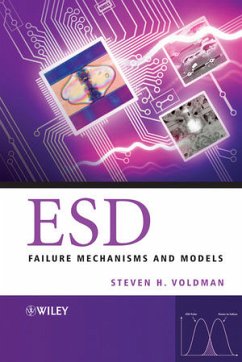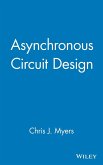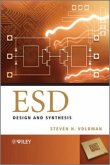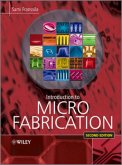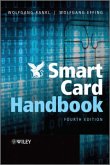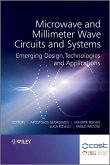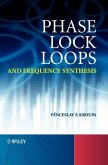- Gebundenes Buch
- Merkliste
- Auf die Merkliste
- Bewerten Bewerten
- Teilen
- Produkt teilen
- Produkterinnerung
- Produkterinnerung
Electrostatic discharge (ESD) failure mechanisms continue to impact semiconductor components and systems as technologies scale from micro- to nano-electronics. This book studies electrical overstress, ESD, and latchup from a failure analysis and case-study approach. It provides a clear insight into the physics of failure from a generalist perspective, followed by investigation of failure mechanisms in specific technologies, circuits, and systems. The book is unique in covering both the failure mechanism and the practical solutions to fix the problem from either a technology or circuit…mehr
Andere Kunden interessierten sich auch für
![Asynchronous Circuit Design Asynchronous Circuit Design]() Chris J. MyersAsynchronous Circuit Design196,99 €
Chris J. MyersAsynchronous Circuit Design196,99 €![Mosfet Models for Spice Simulation Mosfet Models for Spice Simulation]() William LiuMosfet Models for Spice Simulation245,99 €
William LiuMosfet Models for Spice Simulation245,99 €![Esd Esd]() Steven H. VoldmanEsd137,99 €
Steven H. VoldmanEsd137,99 €![Introduction to Microfabrication Introduction to Microfabrication]() Sami FranssilaIntroduction to Microfabrication75,99 €
Sami FranssilaIntroduction to Microfabrication75,99 €![Smart Card Handbook Smart Card Handbook]() Wolfgang RanklSmart Card Handbook188,99 €
Wolfgang RanklSmart Card Handbook188,99 €![Microwave and Millimeter Wave Circuits and Systems Microwave and Millimeter Wave Circuits and Systems]() Apostolos GeorgiadisMicrowave and Millimeter Wave Circuits and Systems151,99 €
Apostolos GeorgiadisMicrowave and Millimeter Wave Circuits and Systems151,99 €![Phase Lock Loops and Frequency Synthesis Phase Lock Loops and Frequency Synthesis]() Vinceslav F. KroupaPhase Lock Loops and Frequency Synthesis206,99 €
Vinceslav F. KroupaPhase Lock Loops and Frequency Synthesis206,99 €-
-
-
Electrostatic discharge (ESD) failure mechanisms continue to impact semiconductor components and systems as technologies scale from micro- to nano-electronics. This book studies electrical overstress, ESD, and latchup from a failure analysis and case-study approach. It provides a clear insight into the physics of failure from a generalist perspective, followed by investigation of failure mechanisms in specific technologies, circuits, and systems. The book is unique in covering both the failure mechanism and the practical solutions to fix the problem from either a technology or circuit methodology. Look inside for extensive coverage on: * failure analysis tools, EOS and ESD failure sources and failure models of semiconductor technology, and how to use failure analysis to design more robust semiconductor components and systems; * electro-thermal models and technologies; the state-of-the-art technologies discussed include CMOS, BiCMOS, silicon on insulator (SOI), bipolar technology, high voltage CMOS (HVCMOS), RF CMOS, smart power, gallium arsenide (GaAs), gallium nitride (GaN), magneto-resistive (MR) , giant magneto-resistors (GMR), tunneling magneto-resistor (TMR), devices; micro electro-mechanical (MEM) systems, and photo-masks and reticles; * practical methods to use failure analysis for the understanding of ESD circuit operation, temperature analysis, power distribution, ground rule development, internal bus distribution, current path analysis, quality metrics, (connecting the theoretical to the practical analysis); * the failure of each key element of a technology from passives, active elements to the circuit, sub-system to package, highlighted by case studies of the elements, circuits and system-on-chip (SOC) in today's products. ESD: Failure Mechanisms and Models is a continuation of the author's series of books on ESD protection. It is an essential reference and a useful insight into the issues that confront modern technology as we enter the Nano-electronic era.
Produktdetails
- Produktdetails
- Verlag: John Wiley & Sons / Turner Publishing Company
- Seitenzahl: 408
- Erscheinungstermin: 1. September 2009
- Englisch
- Abmessung: 252mm x 177mm x 27mm
- Gewicht: 816g
- ISBN-13: 9780470511374
- ISBN-10: 0470511370
- Artikelnr.: 26607357
- Verlag: John Wiley & Sons / Turner Publishing Company
- Seitenzahl: 408
- Erscheinungstermin: 1. September 2009
- Englisch
- Abmessung: 252mm x 177mm x 27mm
- Gewicht: 816g
- ISBN-13: 9780470511374
- ISBN-10: 0470511370
- Artikelnr.: 26607357
Dr Steven H. Voldman received his B.S. in Engineering Science from the University of Buffalo (1979); M.S. EE (1981) and Electrical Engineer Degree (1982) from M.I.T; MS Engineering Physics (1986) and Ph.D EE (1991) from the University of Vermont under IBM's Resident Study Fellow Program. At M.I.T, he worked as a member of the M.I.T. Plasma Fusion Center, and the High Voltage Research Laboratory (HVRL). At IBM, as a reliability device engineer, his work include pioneering work in bipolar/ CMOS SRAM alpha particle and cosmic ray SER simulation, MOSFET gate-induced drain leakage (GIDL) mechanism, hot electron, epitaxy/well design, CMOS latchup, and ESD. Since 1986, he has been responsible for defining the IBM ESD/latchup strategy for CMOS, SOI, BiCMOS and RF CMOS and SiGe technologies. He has authored ESD and latchup publications in the area of MOSFET Scaling, device simulations, copper, low-k, MR heads, CMOS, SOI, Sage and SiGeC technology. Voldman served as SEMATECH ESD Working Group Chairman (1996-2000), ESD Association General Chairman and Board of Directors, International Reliability Physics (IRPS) ESD/Latchup Chairman, International Physical and Failure Analysis (IPFA) Symposium ESD Sub-Committee Chairman, ESD Association Standard Development Chairman on Transmission Line Pulse Testing, ESD Education Committee, and serves on the ISQED Committee, Taiwan ED Conference (T-ESDC) Technical Program Committee. Voldman has provided ESD lectures for universities (e.g. MIT Lecture Series, Taiwan National Chiao-Tung University, and Singapore Nanyang Technical University). He is a recipient of over 125 US patents, over 100 publications, and also provides talks on patenting, and invention. He has been featured in EE Times, Intellectual Property Law and Business and authored the first article on ESD phenomena for the October 2002 edition of Scientific American entitled Lightening Rods for Nanostructures, and Pour La Science, Le Scienze, and Swiat Nauk international editions. Dr. Voldman was recently accepted as the first IEEE Fellow for ESD phenomena in semiconductors for ' contributions to electrostatic discharge protection CMOS, SOI and SiGe technologies'.
About the Author. Preface. Acknowledgments. 1 Failure Analysis and ESD. 1.1
Introduction. 1.2 ESD Failure: How Do Micro-electronic Devices Fail?. 1.3
Sensitivity of Semiconductor Components. 1.4 How Do Semiconductor Chips
Fail--Are the Failures Random or Systematic?. 1.5 Closing Comments and
Summary. Problems. References. 2 Failure Analysis Tools, Models, and
Physics of Failure. 2.1 FA Techniques for Evaluation of ESD Events. 2.2 FA
Tools. 2.3 ESD Simulation: ESD Pulse Models. 2.4 Electro-Thermal Physical
Models. 2.5 Statistical Models for ESD Prediction. 2.6 Closing Comments and
Summary. Problems. References. 3 CMOS Failure Mechanisms. 3.1 Tables of
CMOS ESD Failure Mechanisms. 3.2 LOCOS Isolation-Defined CMOS. 3.3 Shallow
Trench Isolation (STI). 3.4 Polysilicon-Defined Devices. 3.5 Lateral Diode
with Block Mask. 3.6 MOSFETs. 3.7 Resistors. 3.8 Interconnects: Wires,
Vias, and Contacts. 3.9 ESD Failure in CMOS Nanostructures. 3.10 Closing
Comments and Summary. Problems. References. 4 CMOS Circuits: Receivers and
Off-Chip Drivers. 4.1 Tables of CMOS Receiver and OCD ESD Failure
Mechanisms. 4.2 Receiver Circuits. 4.3 Receivers Circuits with ESD
Networks. 4.4 Receiver Circuits with Half-Pass Transmission Gate. 4.5
Receiver with Full-Pass Transmission Gate. 4.6 Receiver, Half-Pass
Transmission Gate, and Keeper Network. 4.7 Receiver Circuit with
Pseudo-zero VT Half-Pass Transmission Gate. 4.8 Receiver with Zero VT
Transmission Gate. 4.9 Receiver Circuits with Bleed Transistors. 4.10
Receiver Circuits with Test Functions. 4.11 Receiver with Schmitt Trigger
Feedback Networks. 4.12 Off-Chip Drivers. 4.13 Single NFET Pull-down OCD.
4.14 Series Cascode MOSFETs. 4.15 I/O Design Considerations and ESD
Parasitic Failure Mechanisms. 4.16 Closing Comments and Summary. Problems.
References. 5 CMOS Integration. 5.1 Table of CMOS Integration ESD Failure
Mechanisms. 5.2 Architecture and Design Synthesis-Related Failures. 5.3
Alternate Current Loop. 5.4 Chip Capacitance. 5.5 ESD Power Clamps. 5.6
Intra- and Inter-domain ESD Protection. 5.7 Split Ground Configurations.
5.8 Mixed Voltage Interface. 5.9 Mixed Signal Interface. 5.10 Inter-domain
Signal Line ESD Failures. 5.11 Decoupling Capacitors. 5.12 System Clock and
Phase-Locked Loop. 5.13 Fuse Networks. 5.14 Bond Pads. 5.15 MOSFET Gate
Structure. 5.16 Fill Shapes. 5.17 No Connects. 5.18 Test Circuitry. 5.19
Multi-chip Systems. 5.20 CMOS Latchup Failures. 5.21 Closing Comments and
Summary. Problems. References. 6 SOI ESD Failure Mechanisms. 6.1 Tables of
SOI Device and Integration ESD Failure Mechanisms. 6.2 SOI N-channel
MOSFETs. 6.3 SOI Diodes. 6.4 SOI Buried Resistors. 6.5 SOI Failure
Mechanisms in 150 nm Technology. 6.6 SOI ESD Failure Mechanisms in 45 nm
Technology. 6.7 SOI ESD Failure Mechanisms in 32 nm Technology. 6.8 SOI ESD
Failure Mechanisms in 22 nm Technology and the Future. 6.9 SOI Design
Synthesis and ESD Failure Mechanisms. 6.10 SOI Integration: ESD Failure
Mechanisms. 6.11 Closing Comments and Summary. Problems. References. 7 RF
CMOS and ESD. 7.1 Tables of RF CMOS ESD Failure Mechanisms. 7.2 RF MOSFET.
7.3 RF Shallow Trench Isolation Diode. 7.4 RF Polysilicon Gated Diode. 7.5
Silicon-Controlled Rectifier. 7.6 Schottky Barrier Diodes. 7.7 Capacitors.
7.8 Resistors. 7.9 Inductors. 7.10 Examples of RF ESD Circuit Failure
Mechanisms. 7.11 Closing Comments and Summary. Problems. Reference. 8
Micro-electromechanical Systems. 8.1 Table of MEM Failure Mechanisms. 8.2
Electrostatically Actuated Devices. 8.3 Micro-mechanical Engines. 8.4
Torsional Ratcheting Actuator. 8.5 Electromagnetic Micro-power Generators.
8.6 MEM Inductors. 8.7 Electrostatically Actuated Variable Capacitor. 8.8
Micro-mechanical Switches. 8.9 RF MEM Switch. 8.10 Micro-mechanical
Mirrors. 8.11 Electrostatically Actuated Torsional Micro-mirrors. 8.12
Closing Comments and Summary. Problems. References. 9 Gallium Arsenide. 9.1
Tables of GaAs-Based ESD Failure Mechanisms. 9.2 GaAs Technology. 9.3 GaAs
Energy-to-failure and Power-to-failure. 9.4 GaAs ESD Failures in Active and
Passive Elements. 9.5 GaAs HBT Devices. 9.6 GaAs HBT-Based Passive
Elements. 9.7 GaAs PHEMT Devices. 9.8 GaAs Power Amplifiers. 9.9 InGaAs.
9.10 Gallium Nitride. 9.11 InP and ESD. 9.12 Closing Comments and Summary.
Problems. References. 10 Smart Power, LDMOS, and BCD Technology. 10.1
Tables of LDMOS ESD Failure Mechanisms. 10.2 LOCOS-Defined LDMOS Devices.
10.3 STI-Defined LDMOS Devices. 10.4 STI-Defined Isolated LDMOS
Transistors. 10.5 LDMOS Transistors: ESD Electrical Measurements. 10.6
LDMOS-Based ESD Networks. 10.7 LDMOS ESD Failure Mechanisms. 10.8 LDMOS
Transistor Design Enhancement. 10.9 Latchup Events in LDMOS and BCD
Technology. 10.10 Closing Comments and Summary. Problems. References. 11
Magnetic Recording. 11.1 Tables of Magnetic Recording Failure Mechanisms.
11.2 MR Heads. 11.3 Inductive Heads. 11.4 GMR Heads. 11.5 TMR Heads. 11.6
ESD Solutions. 11.7 Closing Comments and Summary. Problems. References. 12
Photo-masks and Reticles: Failure Mechanisms. 12.1 Table of Photo-masks ESD
Failure Mechanisms. 12.2 Photo-mask Failure Mechanisms. 12.3 Photo-mask
Inspection Tools. 12.4 Photo-mask ESD Characterization. 12.5 Electrical
Breakdown Versus Gap Spacing. 12.6 Electrical Breakdown in Air: The
Townsend Model. 12.7 Electric Breakdown in Air: Toepler's Spark Law. 12.8
Air Breakdown: The Paschen Breakdown Model. 12.9 Paschen Curve Versus
Reticle Breakdown Plot. 12.10 Electrical Model of Photo-mask Breakdown.
12.11 ESD Latent Damage. 12.12 ESD Damage for Single Versus Multiple
Events. 12.13 ESD Damage to Anti-reflective Coating. 12.14 ESD Solutions in
Photo-masks. 12.15 Closing Comments and Summary. Problems. References.
Index.
Introduction. 1.2 ESD Failure: How Do Micro-electronic Devices Fail?. 1.3
Sensitivity of Semiconductor Components. 1.4 How Do Semiconductor Chips
Fail--Are the Failures Random or Systematic?. 1.5 Closing Comments and
Summary. Problems. References. 2 Failure Analysis Tools, Models, and
Physics of Failure. 2.1 FA Techniques for Evaluation of ESD Events. 2.2 FA
Tools. 2.3 ESD Simulation: ESD Pulse Models. 2.4 Electro-Thermal Physical
Models. 2.5 Statistical Models for ESD Prediction. 2.6 Closing Comments and
Summary. Problems. References. 3 CMOS Failure Mechanisms. 3.1 Tables of
CMOS ESD Failure Mechanisms. 3.2 LOCOS Isolation-Defined CMOS. 3.3 Shallow
Trench Isolation (STI). 3.4 Polysilicon-Defined Devices. 3.5 Lateral Diode
with Block Mask. 3.6 MOSFETs. 3.7 Resistors. 3.8 Interconnects: Wires,
Vias, and Contacts. 3.9 ESD Failure in CMOS Nanostructures. 3.10 Closing
Comments and Summary. Problems. References. 4 CMOS Circuits: Receivers and
Off-Chip Drivers. 4.1 Tables of CMOS Receiver and OCD ESD Failure
Mechanisms. 4.2 Receiver Circuits. 4.3 Receivers Circuits with ESD
Networks. 4.4 Receiver Circuits with Half-Pass Transmission Gate. 4.5
Receiver with Full-Pass Transmission Gate. 4.6 Receiver, Half-Pass
Transmission Gate, and Keeper Network. 4.7 Receiver Circuit with
Pseudo-zero VT Half-Pass Transmission Gate. 4.8 Receiver with Zero VT
Transmission Gate. 4.9 Receiver Circuits with Bleed Transistors. 4.10
Receiver Circuits with Test Functions. 4.11 Receiver with Schmitt Trigger
Feedback Networks. 4.12 Off-Chip Drivers. 4.13 Single NFET Pull-down OCD.
4.14 Series Cascode MOSFETs. 4.15 I/O Design Considerations and ESD
Parasitic Failure Mechanisms. 4.16 Closing Comments and Summary. Problems.
References. 5 CMOS Integration. 5.1 Table of CMOS Integration ESD Failure
Mechanisms. 5.2 Architecture and Design Synthesis-Related Failures. 5.3
Alternate Current Loop. 5.4 Chip Capacitance. 5.5 ESD Power Clamps. 5.6
Intra- and Inter-domain ESD Protection. 5.7 Split Ground Configurations.
5.8 Mixed Voltage Interface. 5.9 Mixed Signal Interface. 5.10 Inter-domain
Signal Line ESD Failures. 5.11 Decoupling Capacitors. 5.12 System Clock and
Phase-Locked Loop. 5.13 Fuse Networks. 5.14 Bond Pads. 5.15 MOSFET Gate
Structure. 5.16 Fill Shapes. 5.17 No Connects. 5.18 Test Circuitry. 5.19
Multi-chip Systems. 5.20 CMOS Latchup Failures. 5.21 Closing Comments and
Summary. Problems. References. 6 SOI ESD Failure Mechanisms. 6.1 Tables of
SOI Device and Integration ESD Failure Mechanisms. 6.2 SOI N-channel
MOSFETs. 6.3 SOI Diodes. 6.4 SOI Buried Resistors. 6.5 SOI Failure
Mechanisms in 150 nm Technology. 6.6 SOI ESD Failure Mechanisms in 45 nm
Technology. 6.7 SOI ESD Failure Mechanisms in 32 nm Technology. 6.8 SOI ESD
Failure Mechanisms in 22 nm Technology and the Future. 6.9 SOI Design
Synthesis and ESD Failure Mechanisms. 6.10 SOI Integration: ESD Failure
Mechanisms. 6.11 Closing Comments and Summary. Problems. References. 7 RF
CMOS and ESD. 7.1 Tables of RF CMOS ESD Failure Mechanisms. 7.2 RF MOSFET.
7.3 RF Shallow Trench Isolation Diode. 7.4 RF Polysilicon Gated Diode. 7.5
Silicon-Controlled Rectifier. 7.6 Schottky Barrier Diodes. 7.7 Capacitors.
7.8 Resistors. 7.9 Inductors. 7.10 Examples of RF ESD Circuit Failure
Mechanisms. 7.11 Closing Comments and Summary. Problems. Reference. 8
Micro-electromechanical Systems. 8.1 Table of MEM Failure Mechanisms. 8.2
Electrostatically Actuated Devices. 8.3 Micro-mechanical Engines. 8.4
Torsional Ratcheting Actuator. 8.5 Electromagnetic Micro-power Generators.
8.6 MEM Inductors. 8.7 Electrostatically Actuated Variable Capacitor. 8.8
Micro-mechanical Switches. 8.9 RF MEM Switch. 8.10 Micro-mechanical
Mirrors. 8.11 Electrostatically Actuated Torsional Micro-mirrors. 8.12
Closing Comments and Summary. Problems. References. 9 Gallium Arsenide. 9.1
Tables of GaAs-Based ESD Failure Mechanisms. 9.2 GaAs Technology. 9.3 GaAs
Energy-to-failure and Power-to-failure. 9.4 GaAs ESD Failures in Active and
Passive Elements. 9.5 GaAs HBT Devices. 9.6 GaAs HBT-Based Passive
Elements. 9.7 GaAs PHEMT Devices. 9.8 GaAs Power Amplifiers. 9.9 InGaAs.
9.10 Gallium Nitride. 9.11 InP and ESD. 9.12 Closing Comments and Summary.
Problems. References. 10 Smart Power, LDMOS, and BCD Technology. 10.1
Tables of LDMOS ESD Failure Mechanisms. 10.2 LOCOS-Defined LDMOS Devices.
10.3 STI-Defined LDMOS Devices. 10.4 STI-Defined Isolated LDMOS
Transistors. 10.5 LDMOS Transistors: ESD Electrical Measurements. 10.6
LDMOS-Based ESD Networks. 10.7 LDMOS ESD Failure Mechanisms. 10.8 LDMOS
Transistor Design Enhancement. 10.9 Latchup Events in LDMOS and BCD
Technology. 10.10 Closing Comments and Summary. Problems. References. 11
Magnetic Recording. 11.1 Tables of Magnetic Recording Failure Mechanisms.
11.2 MR Heads. 11.3 Inductive Heads. 11.4 GMR Heads. 11.5 TMR Heads. 11.6
ESD Solutions. 11.7 Closing Comments and Summary. Problems. References. 12
Photo-masks and Reticles: Failure Mechanisms. 12.1 Table of Photo-masks ESD
Failure Mechanisms. 12.2 Photo-mask Failure Mechanisms. 12.3 Photo-mask
Inspection Tools. 12.4 Photo-mask ESD Characterization. 12.5 Electrical
Breakdown Versus Gap Spacing. 12.6 Electrical Breakdown in Air: The
Townsend Model. 12.7 Electric Breakdown in Air: Toepler's Spark Law. 12.8
Air Breakdown: The Paschen Breakdown Model. 12.9 Paschen Curve Versus
Reticle Breakdown Plot. 12.10 Electrical Model of Photo-mask Breakdown.
12.11 ESD Latent Damage. 12.12 ESD Damage for Single Versus Multiple
Events. 12.13 ESD Damage to Anti-reflective Coating. 12.14 ESD Solutions in
Photo-masks. 12.15 Closing Comments and Summary. Problems. References.
Index.
About the Author. Preface. Acknowledgments. 1 Failure Analysis and ESD. 1.1
Introduction. 1.2 ESD Failure: How Do Micro-electronic Devices Fail?. 1.3
Sensitivity of Semiconductor Components. 1.4 How Do Semiconductor Chips
Fail--Are the Failures Random or Systematic?. 1.5 Closing Comments and
Summary. Problems. References. 2 Failure Analysis Tools, Models, and
Physics of Failure. 2.1 FA Techniques for Evaluation of ESD Events. 2.2 FA
Tools. 2.3 ESD Simulation: ESD Pulse Models. 2.4 Electro-Thermal Physical
Models. 2.5 Statistical Models for ESD Prediction. 2.6 Closing Comments and
Summary. Problems. References. 3 CMOS Failure Mechanisms. 3.1 Tables of
CMOS ESD Failure Mechanisms. 3.2 LOCOS Isolation-Defined CMOS. 3.3 Shallow
Trench Isolation (STI). 3.4 Polysilicon-Defined Devices. 3.5 Lateral Diode
with Block Mask. 3.6 MOSFETs. 3.7 Resistors. 3.8 Interconnects: Wires,
Vias, and Contacts. 3.9 ESD Failure in CMOS Nanostructures. 3.10 Closing
Comments and Summary. Problems. References. 4 CMOS Circuits: Receivers and
Off-Chip Drivers. 4.1 Tables of CMOS Receiver and OCD ESD Failure
Mechanisms. 4.2 Receiver Circuits. 4.3 Receivers Circuits with ESD
Networks. 4.4 Receiver Circuits with Half-Pass Transmission Gate. 4.5
Receiver with Full-Pass Transmission Gate. 4.6 Receiver, Half-Pass
Transmission Gate, and Keeper Network. 4.7 Receiver Circuit with
Pseudo-zero VT Half-Pass Transmission Gate. 4.8 Receiver with Zero VT
Transmission Gate. 4.9 Receiver Circuits with Bleed Transistors. 4.10
Receiver Circuits with Test Functions. 4.11 Receiver with Schmitt Trigger
Feedback Networks. 4.12 Off-Chip Drivers. 4.13 Single NFET Pull-down OCD.
4.14 Series Cascode MOSFETs. 4.15 I/O Design Considerations and ESD
Parasitic Failure Mechanisms. 4.16 Closing Comments and Summary. Problems.
References. 5 CMOS Integration. 5.1 Table of CMOS Integration ESD Failure
Mechanisms. 5.2 Architecture and Design Synthesis-Related Failures. 5.3
Alternate Current Loop. 5.4 Chip Capacitance. 5.5 ESD Power Clamps. 5.6
Intra- and Inter-domain ESD Protection. 5.7 Split Ground Configurations.
5.8 Mixed Voltage Interface. 5.9 Mixed Signal Interface. 5.10 Inter-domain
Signal Line ESD Failures. 5.11 Decoupling Capacitors. 5.12 System Clock and
Phase-Locked Loop. 5.13 Fuse Networks. 5.14 Bond Pads. 5.15 MOSFET Gate
Structure. 5.16 Fill Shapes. 5.17 No Connects. 5.18 Test Circuitry. 5.19
Multi-chip Systems. 5.20 CMOS Latchup Failures. 5.21 Closing Comments and
Summary. Problems. References. 6 SOI ESD Failure Mechanisms. 6.1 Tables of
SOI Device and Integration ESD Failure Mechanisms. 6.2 SOI N-channel
MOSFETs. 6.3 SOI Diodes. 6.4 SOI Buried Resistors. 6.5 SOI Failure
Mechanisms in 150 nm Technology. 6.6 SOI ESD Failure Mechanisms in 45 nm
Technology. 6.7 SOI ESD Failure Mechanisms in 32 nm Technology. 6.8 SOI ESD
Failure Mechanisms in 22 nm Technology and the Future. 6.9 SOI Design
Synthesis and ESD Failure Mechanisms. 6.10 SOI Integration: ESD Failure
Mechanisms. 6.11 Closing Comments and Summary. Problems. References. 7 RF
CMOS and ESD. 7.1 Tables of RF CMOS ESD Failure Mechanisms. 7.2 RF MOSFET.
7.3 RF Shallow Trench Isolation Diode. 7.4 RF Polysilicon Gated Diode. 7.5
Silicon-Controlled Rectifier. 7.6 Schottky Barrier Diodes. 7.7 Capacitors.
7.8 Resistors. 7.9 Inductors. 7.10 Examples of RF ESD Circuit Failure
Mechanisms. 7.11 Closing Comments and Summary. Problems. Reference. 8
Micro-electromechanical Systems. 8.1 Table of MEM Failure Mechanisms. 8.2
Electrostatically Actuated Devices. 8.3 Micro-mechanical Engines. 8.4
Torsional Ratcheting Actuator. 8.5 Electromagnetic Micro-power Generators.
8.6 MEM Inductors. 8.7 Electrostatically Actuated Variable Capacitor. 8.8
Micro-mechanical Switches. 8.9 RF MEM Switch. 8.10 Micro-mechanical
Mirrors. 8.11 Electrostatically Actuated Torsional Micro-mirrors. 8.12
Closing Comments and Summary. Problems. References. 9 Gallium Arsenide. 9.1
Tables of GaAs-Based ESD Failure Mechanisms. 9.2 GaAs Technology. 9.3 GaAs
Energy-to-failure and Power-to-failure. 9.4 GaAs ESD Failures in Active and
Passive Elements. 9.5 GaAs HBT Devices. 9.6 GaAs HBT-Based Passive
Elements. 9.7 GaAs PHEMT Devices. 9.8 GaAs Power Amplifiers. 9.9 InGaAs.
9.10 Gallium Nitride. 9.11 InP and ESD. 9.12 Closing Comments and Summary.
Problems. References. 10 Smart Power, LDMOS, and BCD Technology. 10.1
Tables of LDMOS ESD Failure Mechanisms. 10.2 LOCOS-Defined LDMOS Devices.
10.3 STI-Defined LDMOS Devices. 10.4 STI-Defined Isolated LDMOS
Transistors. 10.5 LDMOS Transistors: ESD Electrical Measurements. 10.6
LDMOS-Based ESD Networks. 10.7 LDMOS ESD Failure Mechanisms. 10.8 LDMOS
Transistor Design Enhancement. 10.9 Latchup Events in LDMOS and BCD
Technology. 10.10 Closing Comments and Summary. Problems. References. 11
Magnetic Recording. 11.1 Tables of Magnetic Recording Failure Mechanisms.
11.2 MR Heads. 11.3 Inductive Heads. 11.4 GMR Heads. 11.5 TMR Heads. 11.6
ESD Solutions. 11.7 Closing Comments and Summary. Problems. References. 12
Photo-masks and Reticles: Failure Mechanisms. 12.1 Table of Photo-masks ESD
Failure Mechanisms. 12.2 Photo-mask Failure Mechanisms. 12.3 Photo-mask
Inspection Tools. 12.4 Photo-mask ESD Characterization. 12.5 Electrical
Breakdown Versus Gap Spacing. 12.6 Electrical Breakdown in Air: The
Townsend Model. 12.7 Electric Breakdown in Air: Toepler's Spark Law. 12.8
Air Breakdown: The Paschen Breakdown Model. 12.9 Paschen Curve Versus
Reticle Breakdown Plot. 12.10 Electrical Model of Photo-mask Breakdown.
12.11 ESD Latent Damage. 12.12 ESD Damage for Single Versus Multiple
Events. 12.13 ESD Damage to Anti-reflective Coating. 12.14 ESD Solutions in
Photo-masks. 12.15 Closing Comments and Summary. Problems. References.
Index.
Introduction. 1.2 ESD Failure: How Do Micro-electronic Devices Fail?. 1.3
Sensitivity of Semiconductor Components. 1.4 How Do Semiconductor Chips
Fail--Are the Failures Random or Systematic?. 1.5 Closing Comments and
Summary. Problems. References. 2 Failure Analysis Tools, Models, and
Physics of Failure. 2.1 FA Techniques for Evaluation of ESD Events. 2.2 FA
Tools. 2.3 ESD Simulation: ESD Pulse Models. 2.4 Electro-Thermal Physical
Models. 2.5 Statistical Models for ESD Prediction. 2.6 Closing Comments and
Summary. Problems. References. 3 CMOS Failure Mechanisms. 3.1 Tables of
CMOS ESD Failure Mechanisms. 3.2 LOCOS Isolation-Defined CMOS. 3.3 Shallow
Trench Isolation (STI). 3.4 Polysilicon-Defined Devices. 3.5 Lateral Diode
with Block Mask. 3.6 MOSFETs. 3.7 Resistors. 3.8 Interconnects: Wires,
Vias, and Contacts. 3.9 ESD Failure in CMOS Nanostructures. 3.10 Closing
Comments and Summary. Problems. References. 4 CMOS Circuits: Receivers and
Off-Chip Drivers. 4.1 Tables of CMOS Receiver and OCD ESD Failure
Mechanisms. 4.2 Receiver Circuits. 4.3 Receivers Circuits with ESD
Networks. 4.4 Receiver Circuits with Half-Pass Transmission Gate. 4.5
Receiver with Full-Pass Transmission Gate. 4.6 Receiver, Half-Pass
Transmission Gate, and Keeper Network. 4.7 Receiver Circuit with
Pseudo-zero VT Half-Pass Transmission Gate. 4.8 Receiver with Zero VT
Transmission Gate. 4.9 Receiver Circuits with Bleed Transistors. 4.10
Receiver Circuits with Test Functions. 4.11 Receiver with Schmitt Trigger
Feedback Networks. 4.12 Off-Chip Drivers. 4.13 Single NFET Pull-down OCD.
4.14 Series Cascode MOSFETs. 4.15 I/O Design Considerations and ESD
Parasitic Failure Mechanisms. 4.16 Closing Comments and Summary. Problems.
References. 5 CMOS Integration. 5.1 Table of CMOS Integration ESD Failure
Mechanisms. 5.2 Architecture and Design Synthesis-Related Failures. 5.3
Alternate Current Loop. 5.4 Chip Capacitance. 5.5 ESD Power Clamps. 5.6
Intra- and Inter-domain ESD Protection. 5.7 Split Ground Configurations.
5.8 Mixed Voltage Interface. 5.9 Mixed Signal Interface. 5.10 Inter-domain
Signal Line ESD Failures. 5.11 Decoupling Capacitors. 5.12 System Clock and
Phase-Locked Loop. 5.13 Fuse Networks. 5.14 Bond Pads. 5.15 MOSFET Gate
Structure. 5.16 Fill Shapes. 5.17 No Connects. 5.18 Test Circuitry. 5.19
Multi-chip Systems. 5.20 CMOS Latchup Failures. 5.21 Closing Comments and
Summary. Problems. References. 6 SOI ESD Failure Mechanisms. 6.1 Tables of
SOI Device and Integration ESD Failure Mechanisms. 6.2 SOI N-channel
MOSFETs. 6.3 SOI Diodes. 6.4 SOI Buried Resistors. 6.5 SOI Failure
Mechanisms in 150 nm Technology. 6.6 SOI ESD Failure Mechanisms in 45 nm
Technology. 6.7 SOI ESD Failure Mechanisms in 32 nm Technology. 6.8 SOI ESD
Failure Mechanisms in 22 nm Technology and the Future. 6.9 SOI Design
Synthesis and ESD Failure Mechanisms. 6.10 SOI Integration: ESD Failure
Mechanisms. 6.11 Closing Comments and Summary. Problems. References. 7 RF
CMOS and ESD. 7.1 Tables of RF CMOS ESD Failure Mechanisms. 7.2 RF MOSFET.
7.3 RF Shallow Trench Isolation Diode. 7.4 RF Polysilicon Gated Diode. 7.5
Silicon-Controlled Rectifier. 7.6 Schottky Barrier Diodes. 7.7 Capacitors.
7.8 Resistors. 7.9 Inductors. 7.10 Examples of RF ESD Circuit Failure
Mechanisms. 7.11 Closing Comments and Summary. Problems. Reference. 8
Micro-electromechanical Systems. 8.1 Table of MEM Failure Mechanisms. 8.2
Electrostatically Actuated Devices. 8.3 Micro-mechanical Engines. 8.4
Torsional Ratcheting Actuator. 8.5 Electromagnetic Micro-power Generators.
8.6 MEM Inductors. 8.7 Electrostatically Actuated Variable Capacitor. 8.8
Micro-mechanical Switches. 8.9 RF MEM Switch. 8.10 Micro-mechanical
Mirrors. 8.11 Electrostatically Actuated Torsional Micro-mirrors. 8.12
Closing Comments and Summary. Problems. References. 9 Gallium Arsenide. 9.1
Tables of GaAs-Based ESD Failure Mechanisms. 9.2 GaAs Technology. 9.3 GaAs
Energy-to-failure and Power-to-failure. 9.4 GaAs ESD Failures in Active and
Passive Elements. 9.5 GaAs HBT Devices. 9.6 GaAs HBT-Based Passive
Elements. 9.7 GaAs PHEMT Devices. 9.8 GaAs Power Amplifiers. 9.9 InGaAs.
9.10 Gallium Nitride. 9.11 InP and ESD. 9.12 Closing Comments and Summary.
Problems. References. 10 Smart Power, LDMOS, and BCD Technology. 10.1
Tables of LDMOS ESD Failure Mechanisms. 10.2 LOCOS-Defined LDMOS Devices.
10.3 STI-Defined LDMOS Devices. 10.4 STI-Defined Isolated LDMOS
Transistors. 10.5 LDMOS Transistors: ESD Electrical Measurements. 10.6
LDMOS-Based ESD Networks. 10.7 LDMOS ESD Failure Mechanisms. 10.8 LDMOS
Transistor Design Enhancement. 10.9 Latchup Events in LDMOS and BCD
Technology. 10.10 Closing Comments and Summary. Problems. References. 11
Magnetic Recording. 11.1 Tables of Magnetic Recording Failure Mechanisms.
11.2 MR Heads. 11.3 Inductive Heads. 11.4 GMR Heads. 11.5 TMR Heads. 11.6
ESD Solutions. 11.7 Closing Comments and Summary. Problems. References. 12
Photo-masks and Reticles: Failure Mechanisms. 12.1 Table of Photo-masks ESD
Failure Mechanisms. 12.2 Photo-mask Failure Mechanisms. 12.3 Photo-mask
Inspection Tools. 12.4 Photo-mask ESD Characterization. 12.5 Electrical
Breakdown Versus Gap Spacing. 12.6 Electrical Breakdown in Air: The
Townsend Model. 12.7 Electric Breakdown in Air: Toepler's Spark Law. 12.8
Air Breakdown: The Paschen Breakdown Model. 12.9 Paschen Curve Versus
Reticle Breakdown Plot. 12.10 Electrical Model of Photo-mask Breakdown.
12.11 ESD Latent Damage. 12.12 ESD Damage for Single Versus Multiple
Events. 12.13 ESD Damage to Anti-reflective Coating. 12.14 ESD Solutions in
Photo-masks. 12.15 Closing Comments and Summary. Problems. References.
Index.

